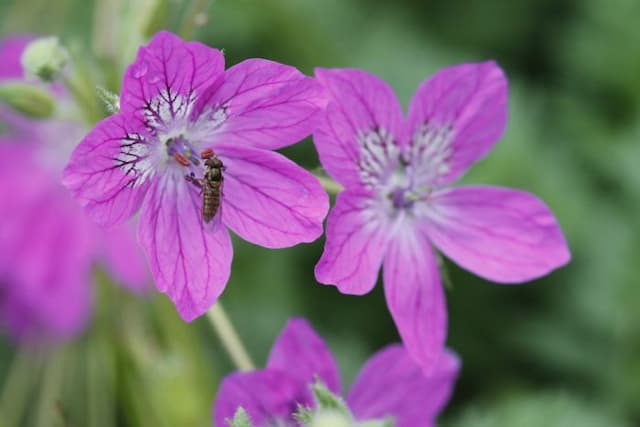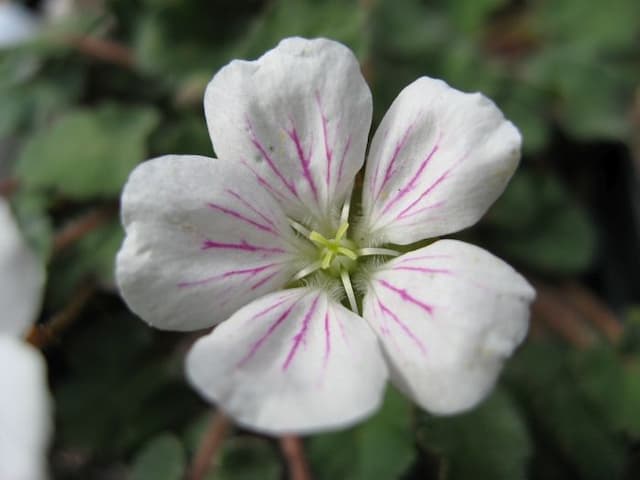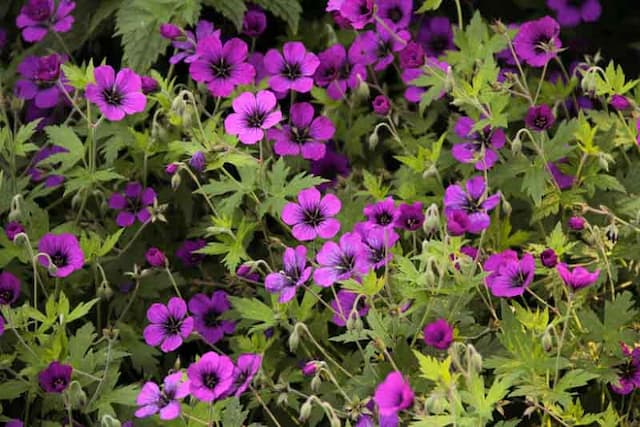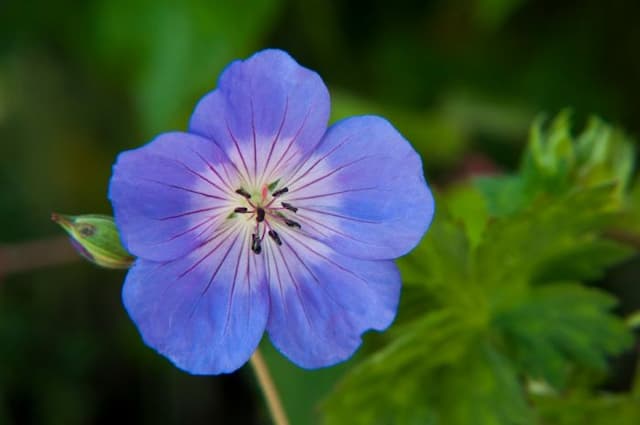Scented Geranium Pelargonium 'Copthorne' (U/sc)

ABOUT
Pelargonium 'Copthorne', commonly known as geranium, is a flowering plant renowned for its ornamental appeal. Its physical characteristics include lush foliage and vibrant blooms that attract attention in any setting. The leaves are striking, typically green with a unique zonal pattern that is often darker in color, adding a layer of visual interest and contrast. These leaves can be slightly ruffled or smooth edged, and they emit a pleasing fragrance when brushed or crushed. The geranium's flowers are particularly captivating, arranged in clusters called umbels that stand out against the greenery. These blooms are semi-double to double in form, providing a full, rounded appearance and come in a captivating shade of magenta or deep reddish-pink. Each petal may have subtle yet distinct markings, with some showcasing a darker hue towards the base, creating a stunning gradient effect. Adorning garden spaces, patios, or containers, the geranium has a bushy and robust demeanor, with stems that are both sturdy and succulent. The plant has a natural, mounded habit, giving it a neat and compact appearance. This, alongside its bright and colorful blossoms, makes it a popular choice for gardeners looking to inject a splash of color into their outdoor spaces or as a houseplant in sunnier indoor locations.
About this plant
 Names
NamesSynonyms
Copthorne Geranium, Scented Geranium.
Common names
Pelargonium 'Copthorne'
 Toxicity
ToxicityTo humans
Geraniums, such as the Pelargonium 'Copthorne', are generally considered non-toxic to humans. However, if ingested in large quantities, they may cause mild gastrointestinal symptoms such as vomiting or diarrhea. Handling the plant may sometimes cause skin irritation in individuals with sensitive skin.
To pets
Geraniums, including the Pelargonium 'Copthorne', can be toxic to pets, especially cats and dogs. Ingesting parts of the plant can result in symptoms such as vomiting, anorexia, depression, and dermatitis. In some cases, if a large amount of the plant is consumed, it may lead to more serious consequences like kidney failure or depression of the central nervous system. If you suspect your pet has ingested geranium, it is important to seek veterinary care immediately.
 Characteristics
CharacteristicsLife cycle
Perennials
Foliage type
Evergreen
Color of leaves
Varied
Flower color
Magenta
Height
2 feet (60 cm)
Spread
2 feet (60 cm)
Plant type
Herb
Hardiness zones
9
Native area
South Africa
Benefits
 General Benefits
General Benefits- Decorative Appeal: The plant has attractive foliage and unique flowers that can enhance the aesthetic of gardens and indoor spaces.
- Drought Tolerance: Being a succulent, this plant is well-suited to survive in dry conditions, requiring less frequent watering than many other species.
- Low Maintenance: It's relatively easy to care for, making it ideal for novice gardeners or those with busy lifestyles.
- Seasonal Interest: Pelargonium 'Copthorne' blooms in spring and summer, providing seasonal color to your garden or home.
- Pest Resistance: They are often resistant to common garden pests, reducing the need for chemical pest control.
- Attracts Pollinators: The flowers can attract beneficial insects such as bees and butterflies, which are important for pollination.
- Container Gardening: This plant is well-suited for container gardening, making it adaptable for patios, balconies, and indoor settings.
- Versatility: It can be used in various landscape designs, including borders, rock gardens, and as ground cover.
- Long Blooming Period: This variety often has a longer blooming period compared to other garden plants, offering prolonged visual interest.
- Heritage Value: Possessing historical and cultural significance, it can be a point of interest for garden enthusiasts and history buffs.
 Medical Properties
Medical PropertiesThis plant is not used for medical purposes.
 Air-purifying Qualities
Air-purifying QualitiesThis plant is not specifically known for air purifying qualities.
 Other Uses
Other Uses- Potpourri Ingredient: The fragrant leaves of Pelargonium 'Copthorne' can be dried and used in potpourri mixes to provide a pleasant scent for the home.
- Flavoring in Desserts: The edible flowers and leaves can be used to impart a subtle rose flavor to cakes, jams, or ice creams.
- Gardening Education: Teaching children about plant growth and botany using this easy-to-grow geranium, which can even be used in science projects.
- Insect Repellent: Growing the plant near windows or seating areas as it is believed to help repel mosquitoes and other insects due to its scent.
- Art and Craft: The flowers and leaves can be used in pressed flower projects, or the whole plant can be a subject for botanical illustration.
- Homemade Cosmetics: Infuse oil with the leaves to create a fragrant natural oil that can be used in homemade creams or perfumes.
- Natural Dye: The flowers of 'Copthorne' geranium can be used to create a natural dye for fabrics or papers.
- Culinary Presentation: The flowers make an attractive edible garnish for salads and cocktails, adding color and a touch of elegance.
- Aromatherapy: The essential oils extracted from the plant can be used in aromatherapy for their stress-relieving and calming properties.
- Companion Planting: Geranium 'Copthorne' can be planted among vegetables to help deter pests with its strong scent, promoting healthier growth of garden crops.
Interesting Facts
 Feng Shui
Feng ShuiThe Geranium is not used in Feng Shui practice.
 Zodiac Sign Compitability
Zodiac Sign CompitabilityThe Geranium is not used in astrology practice.
 Plant Symbolism
Plant Symbolism- Health and healing: Pelargoniums are often associated with health benefits, notably due to their use in essential oils and folk medicine, symbolizing recovery and vitality.
- Comfort and emotional support: The pleasant scent and the tactile nature of pelargoniums, particularly the geranium variety, provide comfort, making it a symbol of emotional support and the alleviation of stress.
- Friendship: As a common gift plant, pelargoniums, like many other plants given between friends, can represent friendship and the sharing of good times.
- Bridging the gap between generations: Pelargoniums, which are often passed down from generation to generation, symbolize continuity, tradition, and maintaining family ties.
 Water
WaterGeranium 'Copthorne' should be watered when the top inch of soil feels dry to the touch, typically every 7 to 10 days, depending on environmental conditions. It's important to water them thoroughly, allowing the water to run through the drainage holes at the bottom of the pot, which usually requires about 8-16 ounces for a standard 6-inch pot. Overwatering can lead to root rot, so it’s crucial to let the soil mostly dry out between watering sessions. During the winter months, reduce watering frequency as the plant's growth slows down.
 Light
LightGeranium 'Copthorne' thrives best in bright, indirect sunlight, but can also tolerate direct morning light with some afternoon shade to prevent leaf scorch. A south-facing or west-facing window would be an ideal location for this plant, providing at least 4-6 hours of daylight. Avoid placing it in too much shade, as this can lead to leggy growth and fewer blooms.
 Temperature
TemperatureGeranium 'Copthorne' prefers temperatures between 65 and 75 degrees Fahrenheit during the day and should not be exposed to temperatures below 50 degrees Fahrenheit for prolonged periods. The plant can survive short dips down to about 30 degrees Fahrenheit but it's best to keep it in a temperature-controlled environment to avoid damage. The ideal nighttime temperature ranges from 55 to 65 degrees Fahrenheit for optimal growth.
 Pruning
PruningGeranium 'Copthorne' benefits from pruning to encourage bushier growth and more blooms. Trim back leggy stems and deadhead spent flowers regularly throughout the growing season to promote new growth. The best time for a more substantial prune is in early spring or after the blooming has finished, which is usually once a year.
 Cleaning
CleaningAs needed
 Soil
SoilGeranium 'Copthorne' thrives in well-draining soil with a pH range of 6.0 to 7.5. A mix of two parts peat moss, one part perlite or sand, and one part garden loam is ideal. Regular feeding with a balanced fertilizer during the growing season is beneficial.
 Repotting
RepottingGeranium 'Copthorne' should be repotted every spring to refresh the soil. Larger pots are not necessary unless the plant has outgrown its current container, as they prefer to be slightly root-bound.
 Humidity & Misting
Humidity & MistingGeranium 'Copthorne' tolerates average indoor humidity levels but benefits from increased circulation. Avoid excessively high humidity to prevent disease.
 Suitable locations
Suitable locationsIndoor
Place Geranium 'Copthorne' near a sunny window with ample light.
Outdoor
Grow Geranium 'Copthorne' in pots with drainage in sunny spots.
Hardiness zone
10-11 USDA
 Life cycle
Life cycleThe Pelargonium 'Copthorne', commonly known as a type of Geranium, begins its life as a seed, which, when sown in a well-draining soil mix and kept at the right temperature, will germinate. After sprouting, the young seedlings gradually develop true leaves and can be transplanted to individual pots or garden beds when they are sufficiently robust. As a vegetative plant, it experiences periods of growth where it develops a bushy structure with thick, lobed leaves and eventually produces clusters of bright, showy flowers that are typically pink or red in hue. After the flowering stage, the plant will produce seeds in a process called seedsetting, completing its reproductive cycle. To continue its growth, the Pelargonium 'Copthorne' can also be propagated vegetatively through cuttings which root readily, giving rise to new plants identical to the parent. In temperate climates, Pelargoniums are perennial plants, and they can survive through winters with appropriate care, entering a dormancy period during which growth slows or ceases until conditions become favorable again in spring.
 Propogation
PropogationPropogation time
Spring-Summer
The favored method for propagating Pelargonium 'Copthorne', commonly known as Scented Geranium, is through stem cuttings. This process is usually most successful during the warm growing season, typically from spring to early summer. To propagate, a healthy stem cutting about 4 to 6 inches (approximately 10 to 15 centimeters) long is selected. The cut should be made just below a leaf node, and the lower leaves are removed to expose a clear section of the stem. The cutting can then be dipped in rooting hormone powder to encourage root development, though this is not always necessary. The prepared cutting is then placed in a well-draining potting mix, moistened and kept in a warm, bright spot out of direct sunlight to root, which typically takes a few weeks. During this time, the soil should be kept consistently moist but not waterlogged to prevent rot.






![Cranesbill [Rothbury Gem]](/_next/image?url=https%3A%2F%2Fplants-admin.emdemapps.com%2Fimages%2Fplants%2F%2Fimages%2F604b6243984c2.png&w=640&q=75)


